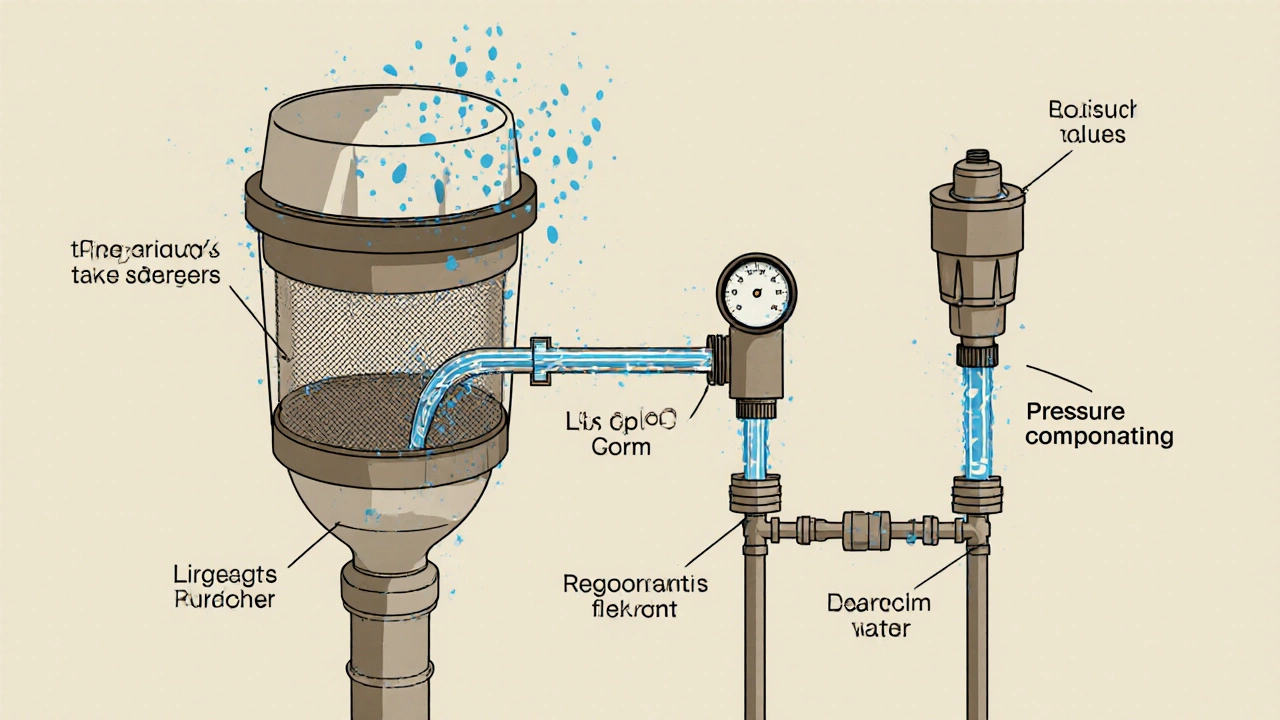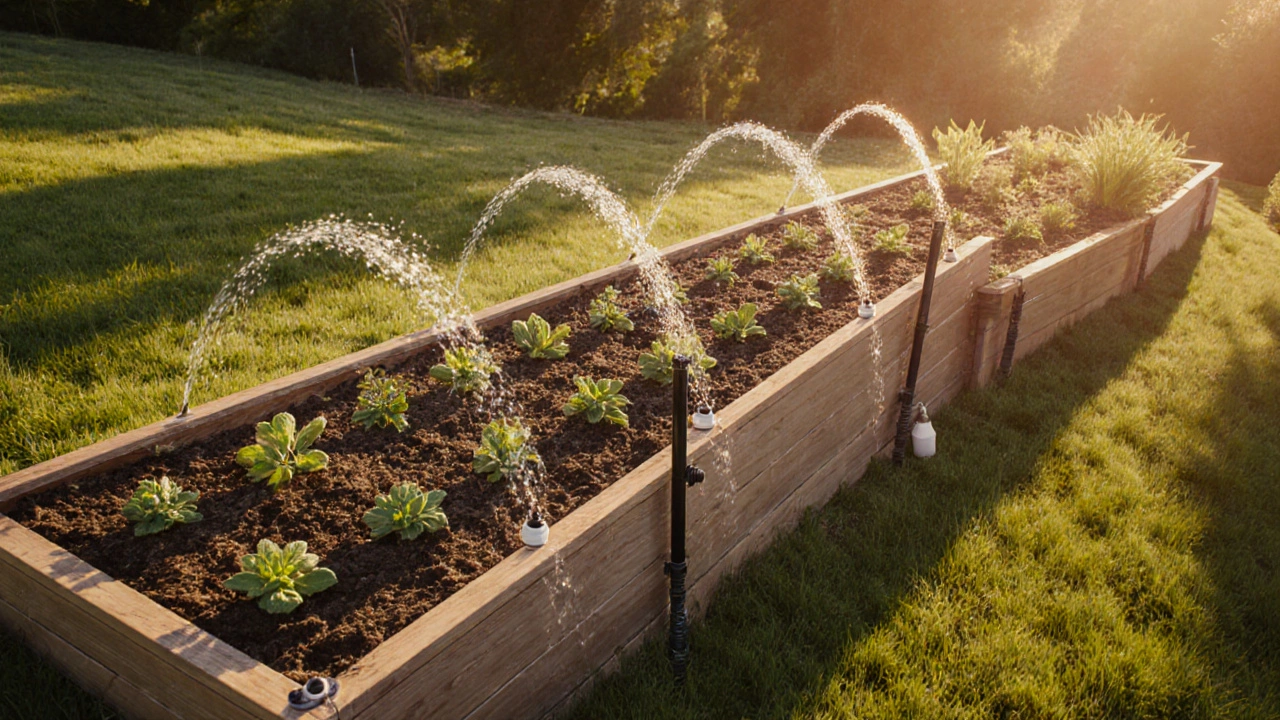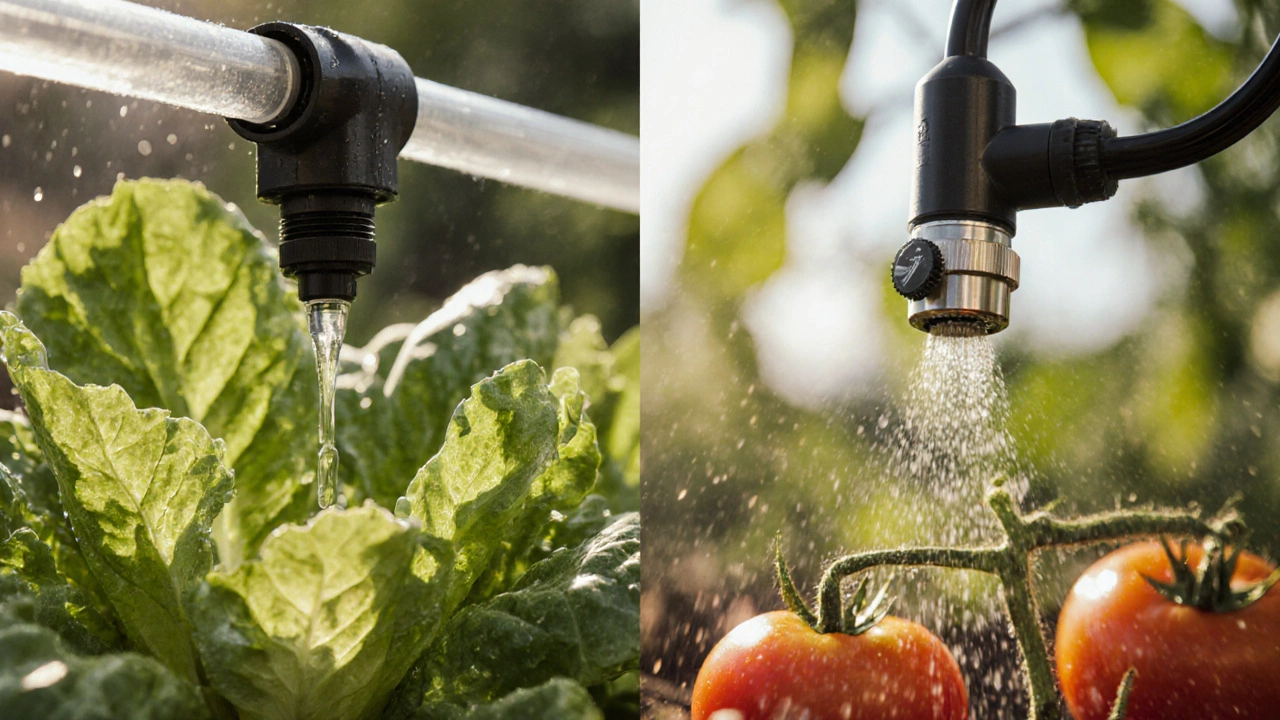Drip System Calculator
Ever wondered why some gardeners swear by a dripper while others reach for an emitter? The choice can affect water usage, plant health, and even your time spent tinkering with the system. Below we break down exactly what sets these two components apart, so you can match the right piece to your garden’s needs.
What is a Dripper?
Dripper is a small, point‑source device that delivers water directly to the base of a plant. It typically attaches to the end of a thin tubing run and releases a steady stream at a fixed rate, often measured in liters per hour (LPH). Drippers are popular for container gardens, raised beds, and any setup where precise, low‑volume watering is essential.
- Fixed flow rates (e.g., 0.5 LPH, 2 LPH, 4 LPH).
- Simple install - just punch a hole in the tubing and push the dripper in.
- Ideal for plants with limited root zones.
What is an Emitter?
Emitter is a broader term that includes any device that releases water from a drip line, but it usually refers to adjustable or pressure‑compensating units. Emitters can be adjustable (you set the flow yourself) or pressure‑compensating (they maintain a constant flow despite pressure changes).
- Flow can be tuned from 0.2 LPH up to 8 LPH or more.
- Often feature a built‑in pressure regulator.
- Works well for uneven terrain or long runs where pressure varies.
How Both Components Deliver Water
Whether you’re using a dripper or an emitter, the basic principle is the same: water travels through a main line, passes through a filter, and then reaches a pressure regulator before exiting the device. The filter catches debris that could clog tiny openings, while the pressure regulator ensures the system stays within the manufacturer’s recommended range (usually 10‑30 psi for most garden‑grade kits).
Flow Rate and Pressure: The Technical Differences
- Fixed vs Adjustable: Drippers come with a set flow that cannot be changed without swapping the part. Emitters, especially adjustable ones, let you fine‑tune the output on the spot.
- Pressure Compensation: Many emitters incorporate a pressure‑compensating membrane. This means water will flow at the same rate even if the pressure fluctuates along a long line. Drippers lack this feature, so flow can vary noticeably across a large garden.
- Uniformity Coefficient: In irrigation engineering, the uniformity coefficient (UC) measures how evenly water is applied. Pressure‑compensating emitters often achieve a UC of 85‑95 %, while standard drippers may drop to 70‑80 % on uneven terrain.

Installation: Practical Steps
Getting either component into your garden is straightforward, but the nuances matter.
- Plan the layout: Sketch your planting beds, noting distances and height changes.
- Run the main line: Use a durable valve to control flow to each zone.
- Insert the device: For a dripper, punch a hole with a special tool and push the dripper in. For an emitter, you might need a threaded fitting or a quick‑connect coupler.
- Test and adjust: Turn the water on, check each point for leaks, and if you’re using adjustable emitters, set the desired flow.
Choosing the Right Component for Your Garden
Use the following checklist to decide which piece fits your setup best.
- Garden size: Small patio containers → drippers; large raised beds with variable elevation → emitters.
- Desired precision: Need exact 0.5 LPH per plant? Dripper. Need flexibility for future plant changes? Adjustable emitter.
- Budget: Drippers are generally cheaper per unit. Emitters cost a bit more but can reduce the number of fittings needed.
- Maintenance: Drippers are simple to replace. Emitters may require occasional recalibration of the pressure‑compensating feature.
Maintenance Tips to Keep Both Running Smoothly
Clogging is the most common headache. Here’s a quick routine to avoid it.
- Flush the system at the start of the season: open the main valve, let water run for 10 minutes, then close.
- Use a fine‑mesh filter rated for 100 microns or less.
- Check each dripper or emitter for mineral buildup, especially in hard‑water areas. Soak a removable dripper in vinegar for 30 minutes if needed.
- Inspect the pressure regulator weekly; replace if the pressure gauge shows drift beyond the recommended range.

Common Misconceptions
Many gardeners assume drippers and emitters are interchangeable, but the reality is a bit more nuanced.
- "All emitters are adjustable" - Not true. Some emitters are fixed‑flow, similar to drippers but with a different housing.
- "Drippers waste water" - If installed correctly and matched to plant water needs, drippers are among the most water‑efficient options.
- "Emitters are always better" - In flat, small gardens, the extra cost and complexity of emitters may not provide any measurable benefit.
Side‑by‑Side Technical Comparison
| Feature | Dripper | Emitter |
|---|---|---|
| Typical flow range | 0.5 - 4 LPH (fixed) | 0.2 - 8 LPH (adjustable) |
| Pressure compensation | No | Yes (in PC models) |
| Installation method | Punch‑hole & push‑in | Threaded or quick‑connect fitting |
| Cost per unit (USD) | $0.30 - $0.80 | $0.60 - $1.50 |
| Best for | Small containers, uniform terrain | Large beds, slopes, variable pressure zones |
Putting It All Together: A Sample Setup
Imagine a 10‑meter raised bed with a slight slope. You could run a ½‑inch main line, install a pressure regulator set at 20 psi, then place an adjustable PC emitter at each plant row. The emitters will keep flow uniform despite the slope, delivering about 1 LPH per tomato plant. If you swapped to drippers, the uphill rows would receive less water unless you added a booster pump.
Final Thoughts
Choosing between a dripper and an emitter isn’t about which one is “better” in absolute terms; it’s about matching the device to the garden’s layout, water pressure, and the level of control you want. By understanding the differences outlined above, you can design a drip system that minimizes waste, maximizes plant health, and fits your budget.
Can I mix drippers and emitters in the same system?
Yes. Mixing is common when different zones have different water‑pressure needs. Just make sure each zone has its own pressure regulator if you use pressure‑compensating emitters alongside fixed‑flow drippers.
What maintenance schedule should I follow?
Flush the entire line at the start of each season, inspect filters monthly, and replace any clogged dripper or emitter after a few weeks of use in hard‑water areas.
Do emitters waste more water than drippers?
Not necessarily. Properly calibrated emitters can be as efficient as drippers. The key is setting the correct flow rate and ensuring uniform pressure.
How do I know which flow rate to choose?
Consult the water‑use guidelines for each plant type. For example, lettuce needs about 0.5 LPH, while tomatoes may require 2 LPH during peak growth.
Is a pressure regulator always required?
If you’re using pressure‑compensating emitters, a regulator helps keep the system at the optimal range. For simple dripper setups on flat terrain, a regulator is optional but can protect against spikes.

